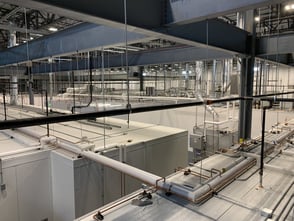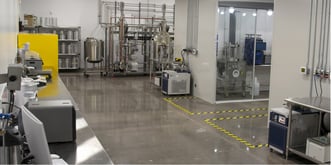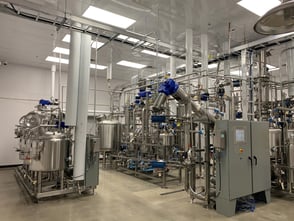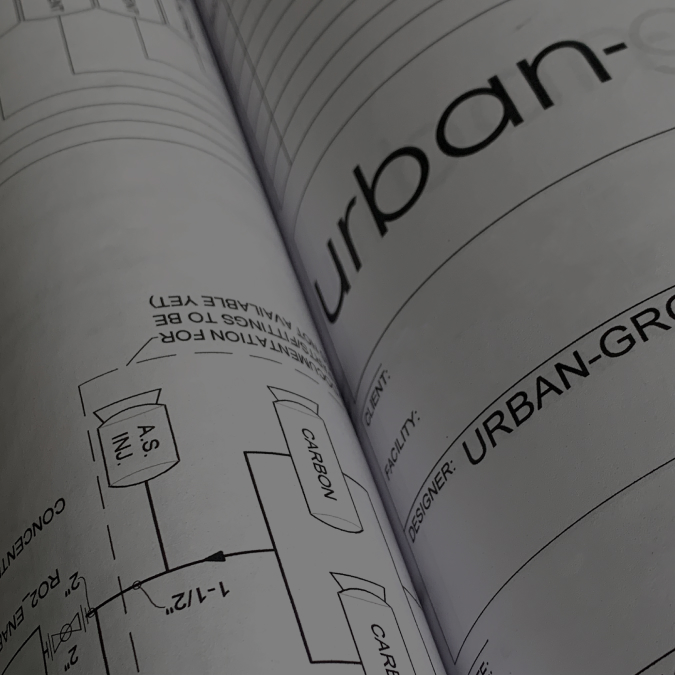Controlled Environment facility design and construction is unlike other commercial building design in that, the criticality of precision climate control is amplified. If an office building is too warm or cool tenants are uncomfortable. By comparison, if temperature or humidity are off in a cold storage facility, food spoils, floors heave, and walls ice over. Imagine a concrete floor slab with a huge crack down the middle in a -10-degree room or a wall that appears to be shimmering thanks to a layer of sheer ice—these real-life examples are the result of improper cold storage facility design and construction.
We walk around daily under real atmospheric pressure that our bodies have grown accustomed to. If you build a room and change the temperature by 2 degrees, the amount of outside pressure on that room attempting to equalize the imbalance is astonishing. Let’s say there’s a pinhole-sized lead in a -20-degree freezer—air will push into that hole at over 100 MPH. With that air comes moisture and when water gets cold, it freezes. Within an hour of that pinhole leak, there’s an ice ball the size of your fist; in 24 hours the ice ball will have expanded on both the outside and inside of the wall creating more leaks and problems.
These examples underscore the importance of working with a Design-Build partner experienced in the intricacies of Controlled Environment facilities. Designing a cold storage facility requires careful consideration of various factors to ensure the optimal functioning of the facility and the preservation of goods. Here are 10 important things to consider:
Temperature Requirements
Understand the specific temperature requirements for the stored goods. Different products may require different temperature ranges, so design the facility to accommodate these variations.
Insulation
Invest in high-quality insulation to minimize heat transfer. Proper insulation helps maintain consistent temperatures and reduces energy costs. Insulated Metal Panels (IMPs) are a great choice when it comes to durability, ease of cleaning, and efficacy. An insulated foam core provides a thermal barrier preventing heat transfer between the interior and exterior of the building while providing structural support and weather resistance.
HVAC Systems
Install an efficient heating, ventilation, and air conditioning (HVAC) system designed for cold storage. This system should be capable of maintaining the required temperatures even during peak loads.
Flooring
Choose flooring materials that are durable, easy to clean, and have good thermal properties. Plenty of owners think, “I understand insulation but why would I need to put HEAT under a freezer floor?” The simple answer: frost heave. Concrete usually takes about five years to truly “dry out” which means the room needs to get cold in a manner that won’t cause the water in the concrete to freeze first. Without a heat source in the floor, you run the risk of moisture freezing under the slab which can result in heaving and displacement. Non-slip surfaces are also essential to ensure safety in cold and potentially wet conditions.
Layout and Storage Systems
Optimize the layout for efficient storage and retrieval of goods. Consider the use of pallet racking systems, automated storage, and retrieval systems (AS/RS), and other space-saving technologies.
Humidity Control
Manage humidity levels to prevent condensation and the formation of ice. Adequate drainage is also a must to effectively handle any moisture before it turns into an icy issue. Excessive humidity can also affect the quality of certain products, so implement systems to control and monitor humidity.
Energy Efficiency
Design the facility with energy efficiency in mind. This includes selecting energy-efficient lighting, HVAC systems, and implementing strategies like proper air sealing and insulation.
Security Measures
Implement robust security measures to protect the stored goods. This may include access control systems, surveillance cameras, and security personnel.
Emergency Backup Systems
Plan for emergency situations by installing backup power systems and alarms. In the event of a power outage or other emergencies, these systems can help prevent spoilage of stored goods.
Regulatory Compliance
Ensure that the facility complies with local and international regulations and standards for cold storage. This may include USDA/FDA food safety regulations, building codes, and environmental regulations.
urban-gro | Cold Storage Facility Design
Given rising populations around the globe and demand for food, it’s projected that the U.S. will be the leading world food producer for the next 15 years. Those operators who are paying attention will recognize that now is the time to invest in expansions and improvements to meet this growing demand. Because cold storage facilities require highly unique and specialized design and construction components compared to typical dry warehouses, it is critical to partner with an experienced architect, contractor, and equipment supplier. Understanding the crucial elements of these specialized facilities such as wall types, refrigeration systems, underfloor heating, vapor barriers, temperature requirements, and more is critical to success.
Poor design derived from a lack of experience and insight can lead to excessive remediation spending and downtime. Working with an experienced team like urban-gro that offers integrated turnkey solutions ensures that your vision is met with the highest level of service delivery.
Contact us to get the conversation started.



